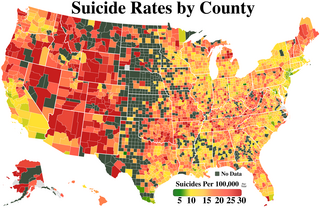Related Research Articles

Gun control, or firearms regulation, is the set of laws or policies that regulate the manufacture, sale, transfer, possession, modification, or use of firearms by civilians.

A copycat suicide is defined as an emulation of another suicide that the person attempting suicide knows about either from local knowledge or due to accounts or depictions of the original suicide on television and in other media. The publicized suicide serves as a trigger, in the absence of protective factors, for the next suicide by a susceptible or suggestible person. This is referred to as suicide contagion.

A veteran is a person who has significant experience and expertise in an occupation or field.
The yellow ribbon is used for various purposes. It may be worn on a person, placed on a vehicle, around a tree, or for a neck tie.
The blue ribbon is a symbol of high quality. The association comes from The Blue Riband, a prize awarded for the fastest crossing of the Atlantic Ocean by passenger liners and, prior to that from Cordon Bleu, which referred to the blue ribbon worn by the French knightly Order of the Holy Spirit. The spelling blue riband is still encountered in most English-speaking countries, but in the United States, the term was altered to blue ribbon, and ribbons of this color came to be awarded for first place in certain athletic or other competitive endeavours. It also may be applied to distinguished members of a group or commission who have convened to address a situation or problem; the usual usage is "blue ribbon commission" or "blue-ribbon panel".

Snort is a free open source network intrusion detection system (IDS) and intrusion prevention system (IPS) created in 1998 by Martin Roesch, founder and former CTO of Sourcefire. Snort is now developed by Cisco, which purchased Sourcefire in 2013.
The orange ribbon is a symbol adopted for a very wide variety of uses in different places.

Awareness ribbons are symbols meant to show support or raise consciousness for a cause. Different colors and patterns are associated with different issues.

The red ribbon, as an awareness ribbon, is used as the symbol for the solidarity of people living with HIV/AIDS, and for the awareness and prevention of drug abuse and drunk driving.
A suicide bridge is a bridge used frequently by people to end their lives, most typically by jumping off and into the water or ground below. A fall from the height of a tall bridge into water may be fatal, although some people have survived jumps from high bridges such as the Golden Gate Bridge. However, significant injury or death is far from certain; numerous studies report minimally injured persons who died from drowning.

Suicide prevention is a collection of efforts to reduce the risk of suicide. Suicide is often preventable, and the efforts to prevent it may occur at the individual, relationship, community, and society level. Suicide is a serious public health problem that can have long-lasting effects on individuals, families, and communities. Preventing suicide requires strategies at all levels of society. This includes prevention and protective strategies for individuals, families, and communities. Suicide can be prevented by learning the warning signs, promoting prevention and resilience, and committing to social change.

"Tie a Yellow Ribbon Round the Ole Oak Tree" is a song recorded by Tony Orlando and Dawn. It was written by Irwin Levine and L. Russell Brown and produced by Hank Medress and Dave Appell, with Motown/Stax backing vocalist Telma Hopkins, Joyce Vincent Wilson and her sister Pamela Vincent on backing vocals. It was a worldwide hit for the group in 1973.

The American Foundation for Suicide Prevention (AFSP) is a voluntary health organization that advocates for research and education around suicide, based in New York City, with a public policy office based in Washington, D.C. The organization's stated mission is to "save lives and bring hope to those affected by suicide."

Breast Cancer Awareness Month (BCAM), also referred to in the United States as National Breast Cancer Awareness Month (NBCAM), is an annual international health campaign organized by major breast cancer charities every October to increase awareness of the disease and raise funds for research into its cause, prevention, diagnosis, treatment, and cure.

Substance abuse prevention, also known as drug abuse prevention, is a process that attempts to prevent the onset of substance use or limit the development of problems associated with using psychoactive substances. Prevention efforts may focus on the individual or their surroundings. A concept that is known as "environmental prevention" focuses on changing community conditions or policies so that the availability of substances is reduced as well as the demand. Individual Substance Abuse Prevention, also known as drug abuse prevention involves numerous different sessions depending on the individual to help cease or reduce the use of substances. The time period to help a specific individual can vary based upon many aspects of an individual. The type of Prevention efforts should be based upon the individual's necessities which can also vary. Substance use prevention efforts typically focus on minors and young adults – especially between 12–35 years of age. Substances typically targeted by preventive efforts include alcohol, tobacco, marijuana, inhalants, coke, methamphetamine, steroids, club drugs, and opioids. Community advocacy against substance use is imperative due to the significant increase in opioid overdoses in the United States alone. It has been estimated that about one hundred and thirty individuals continue to lose their lives daily due to opioid overdoses alone.

Suicide is a major national public health issue in the United States. The country has one of the highest suicide rates among wealthy nations. In 2020, there were 45,799 recorded suicides, up from 42,773 in 2014, according to the CDC's National Center for Health Statistics (NCHS). On average, adjusted for age, the annual U.S. suicide rate increased 30% between 2000 and 2020, from 10.4 to 13.5 suicides per 100,000 people. In 2018, 14.2 people per 100,000 died by suicide, the highest rate recorded in more than 30 years. Due to the stigma surrounding suicide, it is suspected that suicide is generally underreported. In April 2016, the CDC released data showing that the suicide rate in the United States had hit a 30-year high, and later in June 2018, released further data showing that the rate has continued to increase and has increased in every U.S. state except Nevada since 1999. From 2000 to 2020, more than 800,000 people died by suicide in the United States, with males representing 78.7% of all suicides that happened between 2000 and 2020. In 2022, a record high 49,500 people died by suicide, while the suicide rate in 2022 reached its highest level since 1941 at 14.3 per 100,000 persons. Surging death rates from suicide, drug overdoses and alcoholism, what researchers refer to as "deaths of despair", are largely responsible for a consecutive three year decline of life expectancy in the U.S. This constitutes the first three-year drop in life expectancy in the U.S. since the years 1915–1918.
National Suicide Prevention Week (NSPW) is an annual week-long campaign in the United States to inform and engage health professionals and the general public about suicide prevention and warning signs of suicide. By drawing attention to the problem of suicide in the United States, the campaign also strives to reduce the stigma surrounding the topic, as well as encourage the pursuit of mental health assistance and support people who have attempted suicide.

The Yellow Ribbon Reintegration Program (YRRP) is a United States Department of Defense (DoD) effort to promote the well-being of National Guard and Reserve members, their families and communities, by connecting them with resources throughout the deployment cycle. Congress directed the Secretary of Defense to establish the YRRP in 2008 in Section 582 as part of Public Law (PL) 110-181 in direct response to the Nation's recognition of the challenges facing the Reserve Component community. Since 2008, YRRP has served more than 1.4 million Service members and their families. The Yellow Ribbon Reintegration Program is aligned under the Family and Employer Programs and Policy Office within the Office of the Assistant Secretary of Defense for Manpower and Reserve Affairs.

Jack.org is a Canadian non-profit organization focused on youth mental health and suicide prevention. Founded in 2010, the organization has four main programs: Jack Chapters, Jack Talks, Jack Summit, and Jack Ride.
References
- ↑ Freedenthal, Stacey (2010-12-01). "Adolescent Help-Seeking and the Yellow Ribbon Suicide Prevention Program: An Evaluation". Suicide and Life-Threatening Behavior. 40 (6): 628–639. doi:10.1521/suli.2010.40.6.628. ISSN 0363-0234. PMID 21198332.
- ↑ "Yellow Ribbon Suicide Prevention Program : Home". yellowribbon.org. Retrieved 2020-06-01.
- ↑ "News & Events : YELLOW RIBBON WEEK". yellowribbon.org. Retrieved 2020-06-01.
- ↑ "Yellow Ribbon Suicide Prevention Program : Who We Are : Our Story". yellowribbon.org. Retrieved 2020-06-01.